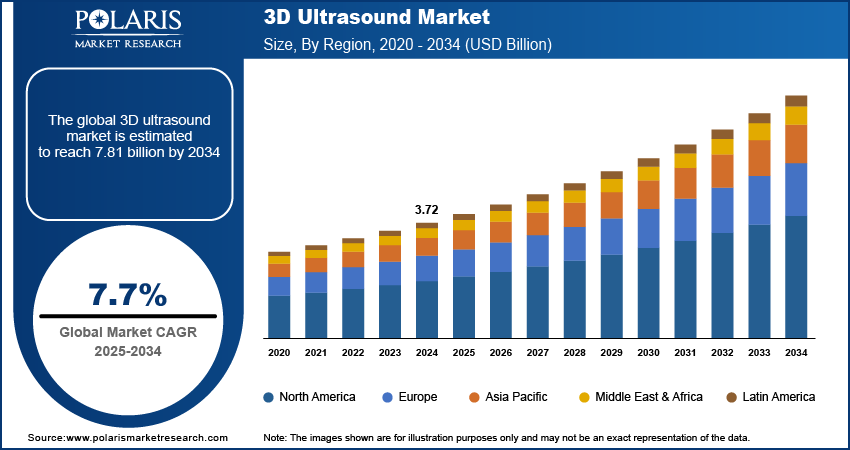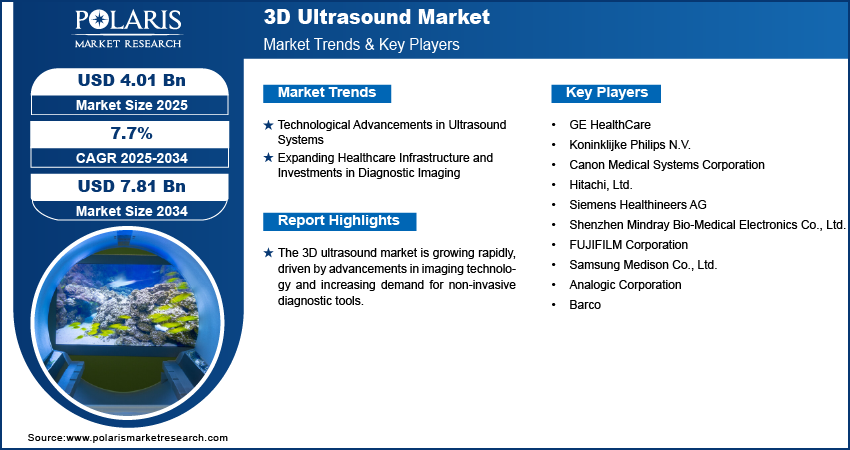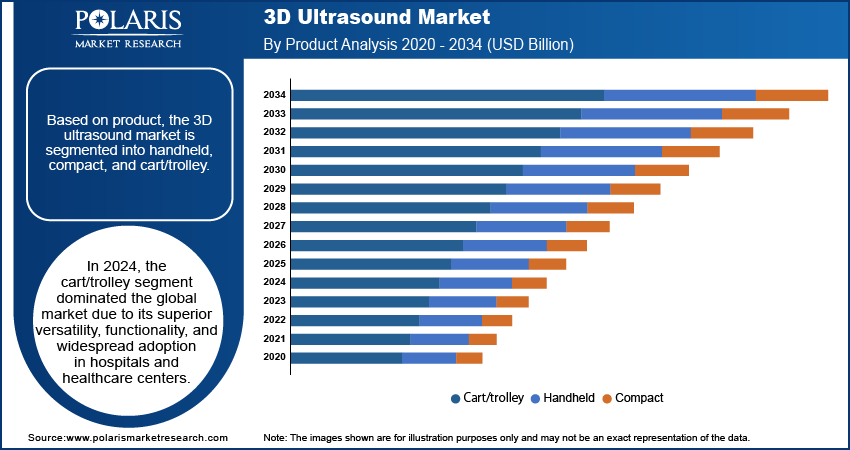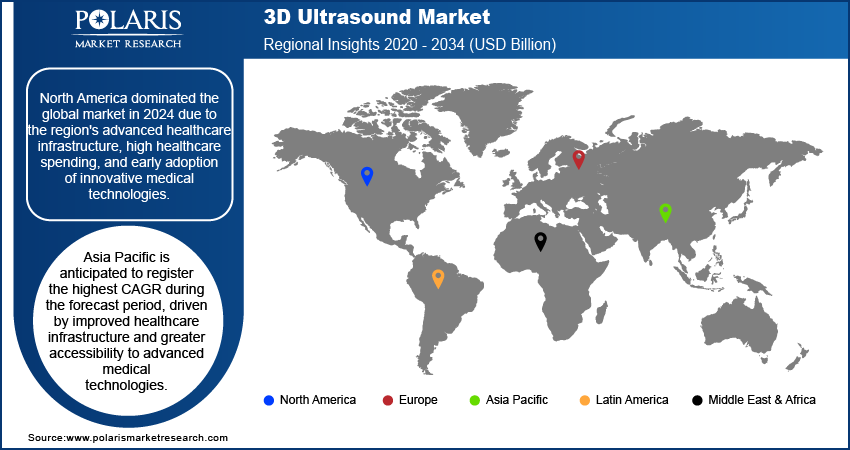
3D Ultrasound Market Size, Share, Trends, Industry Analysis Report: By Product (Handheld, Compact, and Cart/Trolley), Application, End Use, and Region (North America, Europe, Asia Pacific, Latin America, and Middle East & Africa) – Market Forecast 2025–2034
- Published Date:Jan-2025
- Pages: 128
- Format: PDF
- Report ID: PM5357
- Base Year: 2024
- Historical Data: 2020-2023
3D Ultrasound Market Overview
The global 3D ultrasound market size was valued at USD 3.72 billion in 2024. The market is projected to grow from USD 4.01 billion in 2025 to USD 7.81 billion by 2034, exhibiting a CAGR of 7.7% from 2025 to 2034.
3D ultrasound is a medical imaging technique that generates three-dimensional images by combining several two-dimensional ultrasound scans taken from different angles. This method improves the visualization of anatomical structures, making it particularly valuable in fields such as obstetrics and cardiology. In these areas, detailed images of the fetus or heart can assist in diagnosis and treatment planning.
The 3D ultrasound market growth is driven by advancements in imaging technology that provide more detailed views and accurate diagnostics. Factors such as the expansion of healthcare facilities and the increasing importance of diagnostic procedures in patient care are significantly driving the demand for high-quality imaging tools. Innovations in 3D ultrasound, such as AI-enhanced features, are further helping operators to reduce dependency and improve workflow efficiency. Additionally, regulatory approvals and new product launches are boosting the global adoption of 3D ultrasound systems. For instance, in September 2024, PIUR IMAGING received approval for the implementation of 3D ultrasound technology, PIUR tUS Infinity, across the healthcare sector. According to PIUR IMAGING, the approval will allow the company to introduce its advanced ultrasound technology to the US healthcare market for thyroid imaging.

To Understand More About this Research: Request a Free Sample Report
3D Ultrasound Market Dynamics
Technological Advancements in Ultrasound Systems
Technological advancements such as improved cameras and AI-powered features are driving the 3D ultrasound market expansion by enabling superior imaging quality, real-time capabilities, and enhanced diagnostic accuracy. Innovations such as AI integration, enhanced resolution, and better 3D image rendering are allowing healthcare providers to make more precise and faster diagnoses, particularly in obstetrics and cardiology. Additionally, these advancements improve workflow efficiency, reduce repetitive tasks for clinicians, and make ultrasound procedures more accessible and reliable. For instance, in February 2024, GE HealthCare launched the LOGIQ ultrasound portfolio, featuring the new LOGIQ Totus system. This portfolio integrates advanced AI tools to enhance imaging workflows, support diagnostic accuracy, and streamline healthcare operations with digital reporting and management tools. Moreover, as ultrasound systems become more compact and user-friendly, their adoption in diverse clinical settings is expanding, further propelling the growth of the market.
Expanding Healthcare Infrastructure and Advancements in Diagnostic Imaging
Emerging markets, especially in Asia and Latin America, are investing heavily in healthcare facilities and advanced imaging technology to improve patient care and meet rising healthcare demand. As healthcare systems in these regions expand, the market demand for high-resolution, real-time diagnostic tools, such as 3D ultrasound systems, continues to grow. For instance, in October 2024, Smith+Nephew and JointVue partnered for its patented OrthoSonic 3D Surgery Planning Technology, the only ultrasound device currently on the market to deliver 3D preoperative planning in robotics-assisted surgery. Additionally, increased healthcare budgets globally allow facilities to acquire advanced imaging devices to support accurate diagnoses and improved patient outcomes across clinical applications. Thus, the expansion of healthcare infrastructure and increased investments in diagnostic imaging are driving the 3D ultrasound market development.

3D Ultrasound Market Segment Insights
3D Ultrasound Market Assessment Based on Product
The global 3D ultrasound market, based on product, is segmented into handheld, compact, and cart/trolley. In 2024, the cart/trolley ultrasound systems dominated the market due to their superior versatility, functionality, and widespread adoption in hospitals and healthcare centers. These systems offer improved performance, high-end imaging quality, and robust features, making them ideal for detailed diagnostic procedures. The demand is driven by their ability to support complex imaging techniques required in various clinical applications, such as obstetrics and gynecology. Additionally, their mobility and ability to accommodate larger, more advanced imaging equipment make them the preferred choices for healthcare facilities aiming for efficiency and high-quality diagnostics.
3D Ultrasound Market Evaluation Based on Application
The global 3D ultrasound market, based on application, is segmented into general imaging, cardiology, obstetrics and gynecology, urology, and others. The general imaging segment is expected to register the highest CAGR from 2025 to 2034 due to the increasing market demand for non-invasive, accurate diagnostic solutions across a range of medical specialties. Advancements in 3D ultrasound technology enable better visualization of internal structures, making it ideal for routine diagnostic imaging in areas such as abdominal, musculoskeletal, and soft tissue imaging. The growing focus on early disease detection and rising healthcare access, especially in emerging markets, also contribute to the segment’s rapid growth. Additionally, the integration of AI tools and automated features in general imaging ultrasound systems is enhancing diagnostic efficiency, driving the segment’s expansion in the market.

3D Ultrasound Market Regional Analysis
By region, the study provides 3D ultrasound market insights into North America, Europe, Asia Pacific, Latin America, and the Middle East & Africa. North America dominated the global market in 2024 due to the region's advanced healthcare infrastructure, high healthcare spending, and early adoption of innovative medical technologies. The US and Canada are at the forefront of integrating 3D ultrasound systems in hospitals, diagnostic centers, and research institutions, benefiting from a strong regulatory framework and investment in healthcare technologies. Additionally, the increasing prevalence of chronic diseases and the demand for non-invasive diagnostic procedures drive the adoption of 3D ultrasound systems. For instance, in 2024, the US Department of Health and Human Services reported that approximately 129 million individuals in the United States are affected by at least one significant chronic condition, such as heart disease, cancer, diabetes, obesity, and hypertension. These factors, combined with a well-established market for diagnostic imaging, support the dominant position of North America in the 3D ultrasound market.
The Asia Pacific 3D ultrasound market is expected to register the highest CAGR during the forecast period, driven by improved healthcare infrastructure and greater accessibility to advanced medical technologies. Technological innovations, such as portable ultrasound devices, are making diagnostic tools more accessible, especially in rural and underserved areas. For instance, in February 2023, Mindray, a Chinese manufacturer of medical devices, introduced the TE Air, a wireless handheld ultrasound system designed to address the increasing demand from healthcare professionals for advanced portable ultrasound technology. The device is engineered to provide high-definition point-of-care ultrasound (POCUS) imaging, ensuring precision and ease of use for practitioners in diverse clinical environments. Additionally, the aging population in Asia Pacific is driving the demand for effective diagnostic solutions to manage age-related health conditions. These factors, combined with improved healthcare awareness and increased investments in medical technologies, are propelling the regional market demand.

3D Ultrasound Market – Key Players and Competitive Landscape
The 3D ultrasound market is highly competitive, with key players including GE Healthcare, Philips Healthcare, Siemens Healthineers, and Toshiba Medical Systems, among others. These companies dominate through continuous innovation, offering advanced imaging systems with enhanced resolution, real-time capabilities, and ease of use. Strategic partnerships and collaborations, such as Smith+Nephew’s partnership with JointVue for OrthoSonic 3D Surgery Planning Technology, further drive market growth. Additionally, regional players in emerging markets, particularly in Asia and Latin America, are making significant strides by investing in affordable, high-quality 3D ultrasound solutions to meet the rising demand for improved diagnostics. The market is characterized by a focus on expanding product portfolios, enhancing technological features, and addressing diverse clinical needs, creating a dynamic and evolving competitive environment.
A few key major players are GE HealthCare; Koninklijke Philips N.V.; Canon Medical Systems Corporation; Hitachi, Ltd.; Siemens Healthineers AG; Shenzhen Mindray Bio-Medical Electronics Co., Ltd.; FUJIFILM Corporation; Samsung Medison Co., Ltd.; Analogic Corporation; Barco.
Koninklijke Philips N.V., commonly recognized as Philips, is a company that operates in various industries, including healthcare technology, consumer electronics, and lighting. Philips provides medical equipment, software, and services in healthcare, including imaging systems, patient monitoring systems, and clinical informatics solutions. Philips offers a range of mammography solutions, including digital mammography systems, breast tomosynthesis systems, and computer-aided detection (CAD) systems. These technologies are designed to provide high-quality images of breast tissue and help clinicians detect breast cancer at an early stage. In addition to mammography solutions, Philips provides a range of other medical imaging and diagnostic solutions, including ultrasound systems, MRI scanners, CT scanners, and nuclear medicine systems. Philips operates in more than 100 countries worldwide.
GE Healthcare is a healthcare technology company offering various medical devices and technologies, such as magnetic resonance imaging (MRI) machines, computed tomography (CT) scanners, ultrasound machines, X-ray systems, and patient monitoring systems. The company also offers a variety of software solutions and services to help healthcare providers manage and analyze patient data. GE Healthcare’s life care solutions provide a range of products and solutions for patient monitoring, including telemetry systems, fetal monitoring systems, and patient monitors. These systems include advanced features such as wireless connectivity, real-time data visualization, and remote monitoring capabilities. Also, the company provides a range of interventional imaging solutions, including angiography systems, fluoroscopy systems, and interventional ultrasound systems. GE Healthcare’s major focus is on precision health, digital healthcare, and global healthcare access. The company operates in over 160 countries worldwide.
List of Key Companies in 3D Ultrasound Market
- GE HealthCare. GE
- Koninklijke Philips N.V.,
- Canon Medical Systems Corporation
- Hitachi, Ltd.
- Siemens Healthineers AG
- Shenzhen Mindray Bio-Medical Electronics Co., Ltd.
- FUJIFILM Corporation
- Samsung Medison Co., Ltd.
- Analogic Corporation
- Barco
3D Ultrasound Industry Developments
In November 2023, Samsung launched the V6 Ultrasound System, which supports comprehensive imaging in 2D, 3D, and color and is optimized for applications in women's health and urology. According to Samsung, the V6 system has a 510(k) clearance from the US FDA. It is designed to balance affordability with enhanced workflow and productivity features, aiming to support efficient diagnostic practices.
In December 2023, Siemens Healthineers announced the launch of Acuson Maple, an AI-powered ultrasound system equipped with various AI tools aimed at reducing repetitive tasks and improving efficiency in radiology workflows. The company stated that the system is designed to support radiologists in managing workloads and improving overall operational productivity.
3D Ultrasound Market Segmentation
By Product Outlook (Revenue – USD Billion, 2020–2034)
- Handheld
- Compact
- Cart/Trolley
By Application Outlook (Revenue – USD Billion, 2020–2034)
- General Imaging
- Cardiology
- Obstetrics and Gynecology
- Urology
- Others
By End Use Outlook (Revenue – USD Billion, 2020–2034)
- Hospitals
- Diagnostic Imaging Centers
- Others
By Regional Outlook (Revenue – USD Billion, 2020–2034)
- North America
- US
- Canada
- Europe
- Germany
- France
- UK
- Italy
- Spain
- Netherlands
- Russia
- Rest of Europe
- Asia Pacific
- China
- Japan
- India
- Malaysia
- South Korea
- Indonesia
- Australia
- Vietnam
- Rest of Asia Pacific
- Middle East & Africa
- Saudi Arabia
- UAE
- Israel
- South Africa
- Rest of Middle East & Africa
- Latin America
- Mexico
- Brazil
- Argentina
- Rest of Latin America
3D Ultrasound Market Report Scope
|
Report Attributes |
Details |
|
Market Size Value in 2024 |
USD 3.72 billion |
|
Market Size Value in 2025 |
USD 4.01 billion |
|
Revenue Forecast by 2034 |
USD 7.81 billion |
|
CAGR |
7.7% from 2025 to 2034 |
|
Base Year |
2024 |
|
Historical Data |
2020–2023 |
|
Forecast Period |
2025–2034 |
|
Quantitative Units |
Revenue in USD billion and CAGR from 2025 to 2034 |
|
Report Coverage |
Revenue Forecast, Market Competitive Landscape, Growth Factors, and Trends |
|
Segments Covered |
|
|
Regional Scope |
|
|
Competitive Landscape |
|
|
Report Format |
|
|
Customization |
Report customization as per your requirements with respect to countries, regions, and segmentation. |
FAQ's
The global market was valued at USD 3.72 billion in 2024 and is projected to grow to USD 8.78 billion by 2034
The global market is projected to register a CAGR of 7.7% from 2025 to 2034
North America dominated the market for 3D ultrasound in 2024.
A few of the key players in the market are GE HealthCare; Koninklijke Philips N.V.; Canon Medical Systems Corporation; Hitachi, Ltd.; Siemens Healthineers AG; Shenzhen Mindray Bio-Medical Electronics Co., Ltd.; FUJIFILM Corporation; Samsung Medison Co., Ltd.; Analogic Corporation; and Barco.
The cart/trolley segment dominated the 3D ultrasound market in 2024.
The general imaging segment is anticipated to register the highest CAGR during the forecast period.
